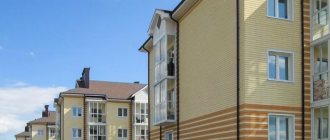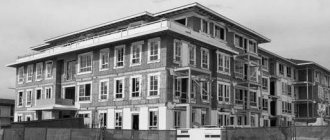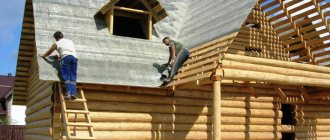Individual housing construction is a form of citizens obtaining housing through construction and registered as personal property, which is carried out by citizens themselves or for their personal money. The legislation of the Russian Federation enshrines the rights of citizens in the Land Code. Plots of land for individual housing construction are a sought-after category of land.
Why were the amendments adopted?
The amendments are intended to streamline individual housing construction. They establish uniform requirements for the construction of residential buildings on land plots provided for the purposes of individual housing construction, running personal subsidiary plots within the boundaries of a settlement, as well as for the construction of residential and garden houses on garden land plots. Maximum building parameters are limited. This change is due to the absence in the legislation, and often in the rules of land use and development, of restrictions on the parameters of such development, which in practice leads to numerous violations, including in terms of the construction of apartment buildings on such land plots. In addition, the mechanism for state construction supervision during the construction of individual housing construction projects has been clarified.
HOW TO OBTAIN LAND FOR INDIVIDUAL HOUSING CONSTRUCTION
The following categories of persons receive the land allotment of individual housing construction free of charge:
- Citizens who have three or more dependent minors. The family must have the status of large. Single parents can also have this status. Land tenure is allocated once. Its size cannot be less than three acres. But the maximum size depends on the region of the Russian Federation;
- Knights of the Order of Labor Glory;
- Heroes of the USSR and other categories provided for by the Legislation of the Russian Federation.
The process of obtaining a land plot free of charge, presented in the Land Code of the Russian Federation, includes the following steps:
- an application for the next allotment is submitted to the local government authority;
- necessary documents are collected;
- provision of allotment.
" Attention! This landholding may be seized. To prevent this from happening, it is better to start construction work in the year the certificate of ownership is received.
After submitting the notification, can I build immediately?
Not really, you need to wait for a notification from the local administration about the compliance or non-compliance of the individual housing construction object (garden house) with the established parameters and the admissibility (inadmissibility) of its placement on the land plot. Local authorities within 7 days check the parameters of future construction (primarily to determine whether the construction complies with the type of permitted use of the land plot and its territorial zone in accordance with local development rules) and sends their notification to the applicant. After this, the developer has the legal right to begin construction. The notice is valid for 10 years.
TYPE OF LOT FOR INDIVIDUAL HOUSING CONSTRUCTION WHAT IS IT
If land ownership, according to official documents, is assigned the category “Individual Housing Construction”, this means that this territory has a designated purpose - creation according to an individual project.
Land properties for individual housing construction are located only in populated areas or municipalities, which is enshrined in law. This gives the right to build a house, but not more than three floors. Such a building receives a specific postal address, and residents, if they intend to live in it permanently, can, if desired, register right here at their place of residence (registration).
An individual housing construction project is a “own residential building,” a building that stands separately on a plot of land and is your property.
The law obliges local self-government bodies of such land ownership to provide the site with all necessary communications and create conditions for access to social facilities: kindergartens, medical institutions, shops, schools.
It is possible to become a landowner by obtaining a bank loan or mortgage.
Do I need to obtain permission to put it into operation upon completion of construction?
No, the law provides for the obligation of the developer, within one month after the completion of construction or reconstruction of an individual housing construction project, to submit a notification to the authorized body about the completion of construction of the house. Based on the results of checking such notification, the authorized body will make a decision on the compliance (non-compliance) of the constructed (reconstructed) facility with the established requirements. The notification must be accompanied by a technical plan for the house and a receipt for payment of the state fee for registering ownership of the house.
VALIDITY DURATION OF PERMISSION
Until 2021, it was possible to begin the creation of a residential construction project only after receiving the appropriate permit. But not for all objects.
From 2021, the permit procedure is different. Now the developer submits a notice of the planned creation of the facility to the authority that is authorized to issue construction permits (Article 51.1, Town Planning Code of the Russian Federation). But in fact the process is not at all simplified. Since this document must be approved by regulatory authorities. The developer is waiting for a decision that the characteristics of the building project, which he stated in the documents, satisfy all legal standards established by the urban planning regulations (the so-called notification of compliance) and the project is approved. And only after that the construction of the object begins.
The document of compliance has a validity period. Ten years from the date of sending the notice of intent, in accordance with Art. 51.19, Town Planning Code of the Russian Federation.
On the issue of the concept of housing construction
When considering the issue of providing land plots for housing construction, it is first necessary to define the concept of housing construction. Despite the fact that this definition is used in many regulatory legal acts, there is currently no legal definition of this concept at the legislative level. Before defining the concept of housing construction, it is necessary to analyze the legal regulation of housing construction.
Relations regarding the provision and use of land plots for housing construction are regulated by the norms of land, housing law and urban planning regulations. The norms of these branches of law provide definitions, after analyzing which you can formulate your own point of view on this concept.
The Housing Code of the Russian Federation [1, Article 19] (hereinafter referred to as the Housing Code of the Russian Federation) contains the concept of housing stock, which is understood as the totality of all residential premises located on the territory of the Russian Federation, regardless of who owns them, what the legal regime for their use is, etc. .. In current legislation, the housing stock is divided depending on the form of ownership into:
1) private housing stock - a set of residential premises owned by citizens and legal entities;
2) state housing stock - a set of residential premises owned by the Russian Federation (housing stock of the Russian Federation), constituent entities of the Russian Federation (housing stock of the constituent entities of the Russian Federation);
3) municipal housing stock - a set of residential premises owned by municipal entities (Part 2 of Article 19 of the Housing Code of the Russian Federation).
There is another classification depending on the purposes of using the housing stock: housing stock for social use, specialized housing stock, individual housing stock, and housing stock for commercial use.
Since the housing stock consists of residential premises, it is important to consider the very concept of residential premises, what criteria it should meet in terms of quality characteristics.
The Housing Code of the Russian Federation establishes that the objects of housing rights are residential premises (Part 1, Article 15). The legal definition of residential premises is given in Art. 15 Housing Code of the Russian Federation. Thus, residential premises are recognized as isolated premises, which are real estate and are suitable for permanent residence of citizens, meeting sanitary rules and regulations, as well as other legal requirements. It is stipulated that residential premises must be intended for the residence of citizens.
Thus, S.I. Kutsina identifies the following characteristics of a residential premises, namely, it must be: 1) legally recognized as a residential premises by an authorized body; this is possible if the residential premises are suitable for permanent residence, i.e., meet all the requirements for residential premises; 2) isolated, i.e. individualized and isolated in space as a residential building, apartment, room, having a separate exit to the street, to a staircase or to a common corridor; 3) relate to real estate due to a strong connection with the land; 4) must be intended for the residence of citizens [2, p. 27].
In accordance with the norms of the Housing Code of the Russian Federation and the Decree of the Government of the Russian Federation “On approval of the Regulations on recognizing premises as residential premises, residential premises unsuitable for habitation and an apartment building as unsafe and subject to demolition or reconstruction” dated January 28, 2006 No. 47 [3], in order to the premises have been recognized as residential, it must meet established requirements and undergo mandatory inspection to be recognized as such. The Housing Code of the Russian Federation defines specific types of objects of housing rights (Article 16). The legislator uses the concept of “residential premises” as a generic one, which covers all types of residential premises. Residential premises include: residential buildings, parts of residential buildings; apartments, parts of apartments; rooms (residential buildings and apartments) [4, p.49]. Let's consider each concept separately.
The housing legislation of the Russian Federation does not contain a definition of the concept of “individual residential building”, defining only the generic concept - “residential building”. So, according to Part 2 of Art. 16 of the Housing Code of the Russian Federation, a residential building is recognized as an individually defined building, which consists of rooms, as well as premises for auxiliary use, intended to satisfy citizens’ household and other needs related to their residence in such a building. Part 3 Art. 48 of the Town Planning Code of the Russian Federation [5, Article 48], individual housing construction projects mean detached residential buildings with no more than three floors, intended for one family.
Therefore, in practice, it can be recommended to proceed from the fact that an individual residential building is a residential building with no more than three floors, created at the expense of one owner or persons related by family relationships, privately owned, intended for residence, as a rule, by one families and related to individual housing stock in accordance with the housing legislation of the Russian Federation. An apartment is a structurally separate room in an apartment building, providing direct access to common areas in such a house and consisting of one or more rooms, as well as auxiliary premises intended to satisfy household and other needs of citizens related to their residence in such a separate room (Part 3 of Article 16 of the Housing Code of the Russian Federation). In accordance with Part 4 of Art. 16 of the Housing Code of the Russian Federation, a room is a part of a residential building or apartment intended for use as a place of direct residence for citizens in such a house or apartment. In addition, the Housing Code of the Russian Federation classifies part of a residential building, as well as part of an apartment, as residential premises.
Therefore, a residential building can be: a residential building for one family (for individual use), including living rooms and other auxiliary premises; a separate apartment in a multi-apartment residential building, consisting of living rooms and other premises (utility rooms); part of a residential building, which consists of one or more living rooms and, as a rule, utility rooms; part of the apartment, i.e. only a room, or rooms. Thus, in accordance with housing legislation, a residential premises is not any premises in which one can live permanently or temporarily (a barracks, a trailer, a mobile home), but only one that is specifically intended for the residence of citizens. This target affiliation determined the legal characteristics that the premises must meet.
It is important to consider the concept of “construction”, which is given in paragraph 13 of Art. 1 of the Town Planning Code of the Russian Federation. In this norm, construction means the creation of buildings, structures, structures (including on the site of demolished capital construction projects). Thus, we can conclude that in the concept of housing construction, the legislator includes the creation of residential buildings, structures, the creation of apartments and rooms included in such buildings.
The concept of housing construction includes the construction of both residential buildings (individual, low-rise and multi-apartment buildings) and the construction of residential buildings, since such buildings are also intended for living and are residential.
Housing construction is carried out in residential zones determined as a result of urban zoning. Residential zones may include: zones with individual residential buildings; development zones with low-rise residential buildings; development zones with mid-rise residential buildings; development zones with multi-storey residential buildings; residential development zones of other types (clause 2 of article 35 of the Town Planning Code of the Russian Federation).
In residential areas it is allowed to place free-standing, built-in or attached facilities for social and communal purposes, healthcare facilities, preschool, primary general and secondary (complete) general education facilities, religious buildings, parking lots, garages, facilities related to the residence of citizens and do not have a negative impact on the environment. Residential zones may also include territories intended for gardening and dacha farming (Clause 3, Article 35 of the Town Planning Code of the Russian Federation). There is an opinion in scientific doctrine about the concept of housing construction. So, for example, M. Yu. Tikhomirov understands housing construction as: “the creation of buildings, structures, structures (including on the site of demolished capital construction projects), as a result of which objects of housing rights will be created.”
In addition, V.V. Grechko offers the following definition of the concept of “providing a land plot in state or municipal ownership for the purposes of housing construction” - these are the actions of the public owner of the land plot aimed at transferring ownership of land plots to individuals or legal entities, or encumbering land plots with real rights of individuals or legal entities in order to satisfy private interests in the construction and subsequent operation of residential real estate, carried out in pursuance of documents of territorial planning and urban zoning, which, at the time of such provision, indicate an exhaustive list of public restrictions and encumbrances of the land plot [ 6, p.8].
Having analyzed the literature related to housing construction, we came to the conclusion that, unfortunately, the domestic doctrine pays very little attention to the development of the concept of “housing construction”. There is no doubt that at the legislative level it is necessary to regulate the rules on housing construction in more detail, to give a concept, to define goals.
In our opinion, housing construction should be considered in a broad and narrow sense. In a broad sense, housing construction is the creation of objects of housing rights, and in a narrow sense, it is the process of constructing residential buildings (residential buildings) and structures suitable for citizens to live in.
Literature:
1. Housing Code of the Russian Federation: Federal Law of December 29, 2004 (as amended and supplemented) // SZ RF. 2005. No. 1 (part 1); 2015. No. 1 (part 1). Art. eleven.
2. Kutsina S.I. Housing law of the Russian Federation. M., 2014.
3. On approval of the Regulations on recognizing premises as residential premises, residential premises unsuitable for habitation and an apartment building as unsafe and subject to demolition or reconstruction: Decree of the Government of the Russian Federation of January 28, 2006 No. 47 (as amended and supplemented) // SZ RF. 2006. No. 6. Art. 702; 2013. No. 15. Art. 1796.
4. Tikhomirov M. Yu. Commentary on the new Housing Code of the Russian Federation. M., 2007.
5. Town Planning Code of the Russian Federation: Federal Law of December 29, 2004 (as amended and supplemented) // SZ RF. 2005. No. 1 (part 1). Art. 16; NW RF. Russian newspaper. 2015. No. 90. 04/28/2015.
6. Grechko V.V. Legal regulation of the provision of land plots for housing construction from lands in state and municipal ownership: abstract. diss...cand. legal Sci. M., 2012.








